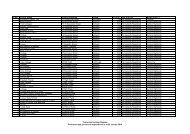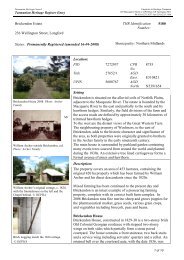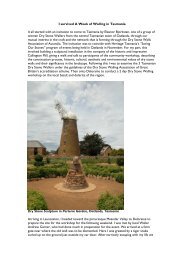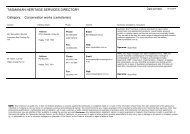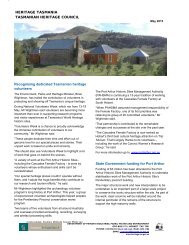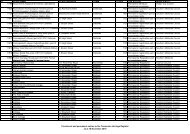Heritage Tasmania
Heritage Tasmania
Heritage Tasmania
You also want an ePaper? Increase the reach of your titles
YUMPU automatically turns print PDFs into web optimized ePapers that Google loves.
Transforming<br />
spaces<br />
The adaptive reuse of a heritage-listed diesel train<br />
workshop in Launceston into the UTAS School of<br />
Architecture shows that excellent design can transform<br />
an industrial space into a cutting edge learning<br />
environment while protecting its heritage values.<br />
The former diesel train workshop sits in the Inveresk Rail<br />
Yard site in Launceston. The site includes a collection of<br />
buildings associated with the development of <strong>Tasmania</strong>’s<br />
rail system. The workshop was constructed circa 1950 and<br />
is representative of an industrial style.<br />
<strong>Heritage</strong> <strong>Tasmania</strong> Works Manager, Ian Boersma, said<br />
the new design for the building was sympathetic to its<br />
industrial heritage. “The building retains a large expanse<br />
of open space typical of an industrial building and the sawtooth<br />
roof, much of the original machinery and the overall<br />
concrete structure remain,” Mr Boersma said.<br />
“The southern facade still has the overall outline<br />
of the diesel workshop. So the place’s original<br />
use is still quite clear,” Mr Boersma explains.<br />
The retention of the building’s heritage integrity resulted<br />
in Six Degrees Architects and Sustainable Built Architects<br />
winning the Australian Institute of Architecture (<strong>Tasmania</strong>)<br />
<strong>Heritage</strong> Architecture Award, and the National AIA Lachlan<br />
Macquarie Award for <strong>Heritage</strong>. The design also won the<br />
<strong>Tasmania</strong>n AIA Sustainability Architecture Award and the<br />
National AIA Award for Sustainability in 2007.<br />
From the outset the conversion of this building was<br />
undertaken with the intention of adopting high<br />
sustainable environmental design standards. Not only<br />
does this building reuse the existing fabric, it includes<br />
low emission materials and recycled and sustainably<br />
resourced materials.<br />
The précis provided for the <strong>Tasmania</strong>n AIA sustainability<br />
award says the results of this planning include achieving<br />
a 40-50 per cent running cost saving over comparable<br />
university buildings, a 54 per cent water use reduction<br />
and a 40 to 50 per cent greenhouse gas reduction.<br />
The new interior provides an environmentally friendly<br />
and contemporary space for students and staff that also<br />
protects the heritage fabric for future generations.<br />
“At the same time, the space provides a light and airy<br />
learning environment for architecture students. This is<br />
a great heritage outcome.”<br />
7





